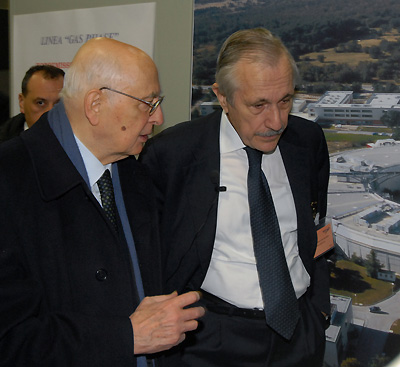
|
Carlo R. Rizzuto University of Genova, and President Sincrotrone Trieste
 visit of the President of the Italian republic to Elettra, march 2008
Scientific activities have been in Materials Sciences and Cryogenics, in particular superconductivity, magnetism and transport properties, cryomedicine and cryoengineering, at the University of Genova and several other Universities: McGill Montreal; Imperial College, London; Santiago, Chile; Zagreb, Croatia; Lausanne, Switzerland. Present research is on the development of Free Electron Lasers and of quantitative methods to measure impacts and socioeconomic returns of research, thus contributing to the development of the FERMI@Elettra project in Trieste and to the first detailed evaluation of Research in Italy (CIVR/report). A specific effort in connecting Research with new enterprises required to set-up and drive the start of a specific Venture Capital (Quantica) He has succeeded Carlo Rubbia and Paolo Fasella as chair of Sincrotrone Trieste in 1999, after acting as CEO from 1996 and having been involved in the decision-making process (1975-1987) which brought Italy to build Elettra and to participate in ESRF-Grenoble , following a proposal by the European Science Foundation (ESF). Italy’s involvement in Elettra and ESRF has been the arrival point of a long process aiming to re-start Italian Research after a political freeze in the early ’60, which brought Materials Sciences to a subcritical level within an overall attack against the development of nuclear and electronic technologies in Italy (publications and comments will be contained in an ad hoc page, in construction). To overcome this situation, Prof Rizzuto has stimulated and supported a coordinated effort involving groups at several universities, developing self-organization and joint projects to achieve critical mass, higher international quality and visibility and higher policy-making capability. This in various functions, in particular as chair of the Physics Committee of the Italian University funds (CUN-Fisica), member of the National Science & Technology Advisory Committee (CNST) and leading the coordinating bodies in the Physics of Matter up to their transformation into a National Institute in 1995 (INFM). The effort in Italy was connected to, and strengthened by, a growing involvement of the European Union in basic research, as a member of the European Science Advisory Committees (CODEST and ESTA). Other international leading roles were the chairs of the International Cryogenic Engineering Committee (ICEC), the Cryogenics Group of the Institut International du Froid (IIR) and of the Metal Physics Group of the European Physical Society (EPS). |
